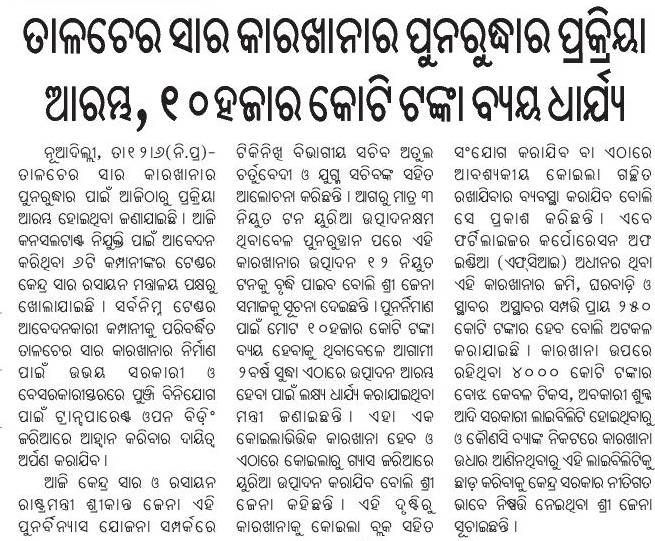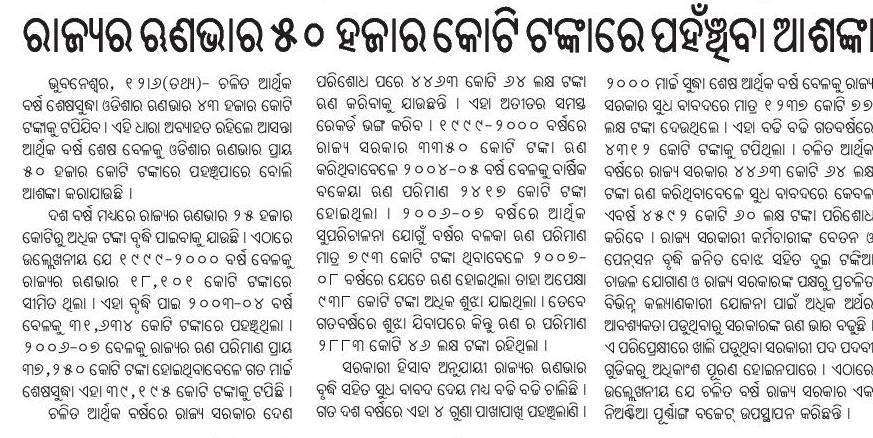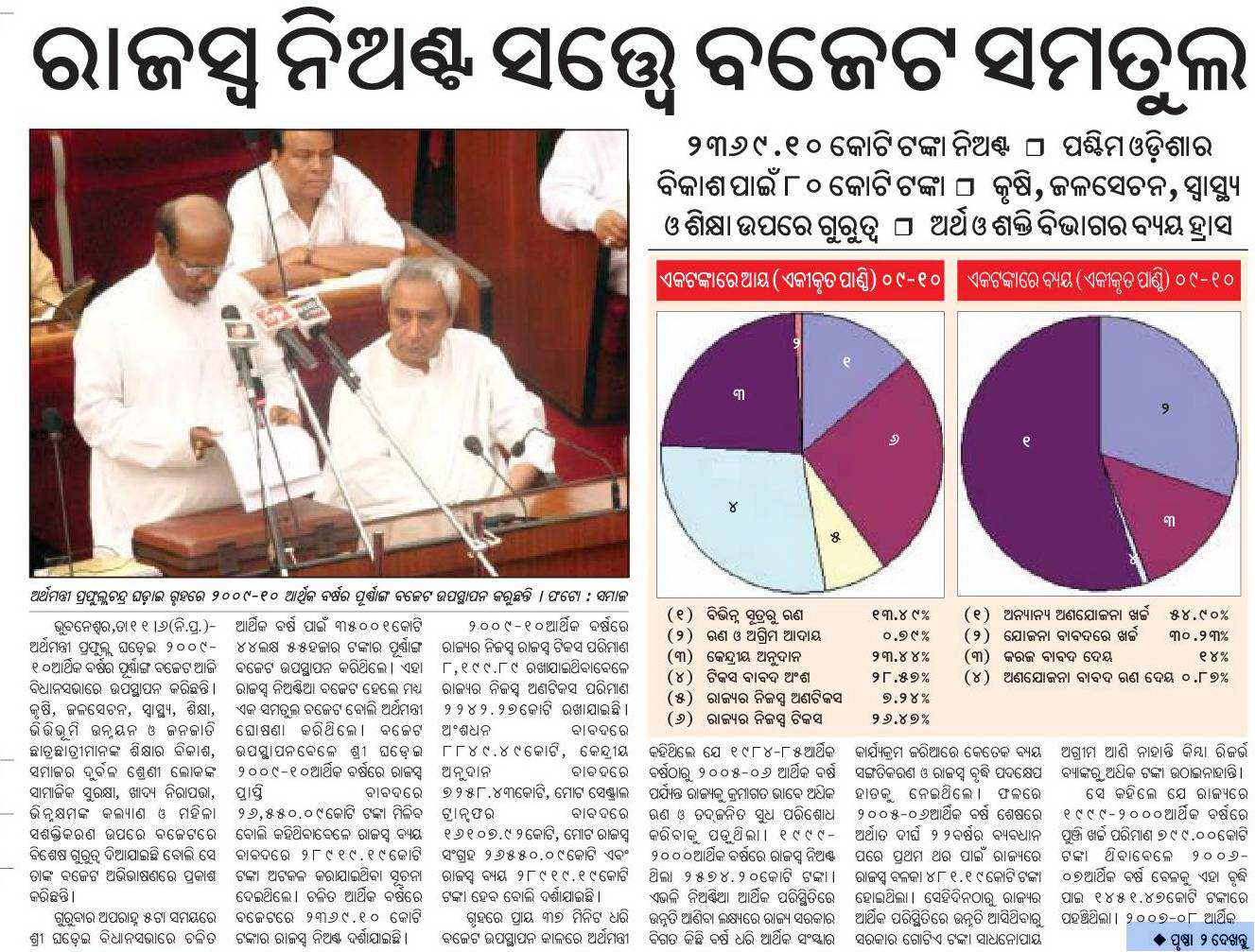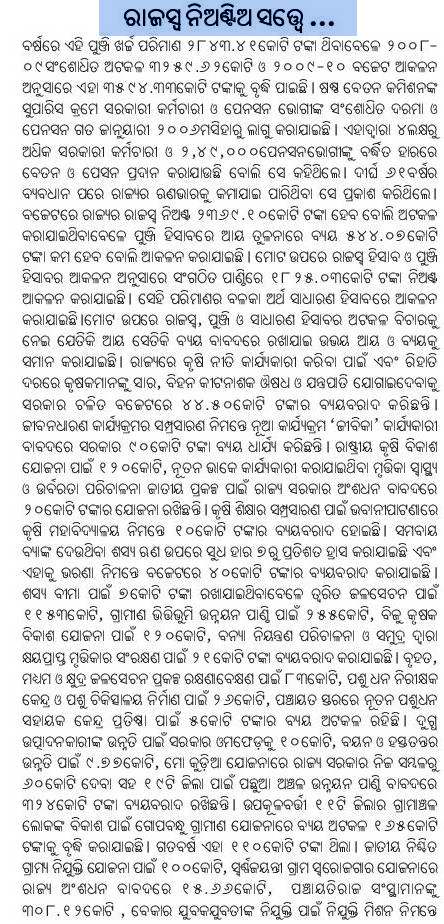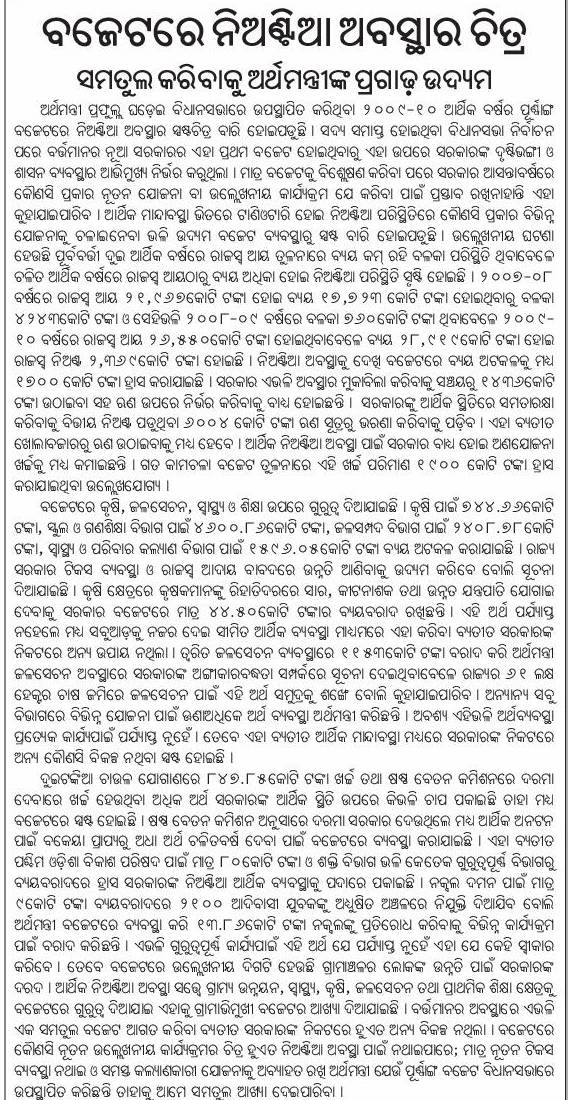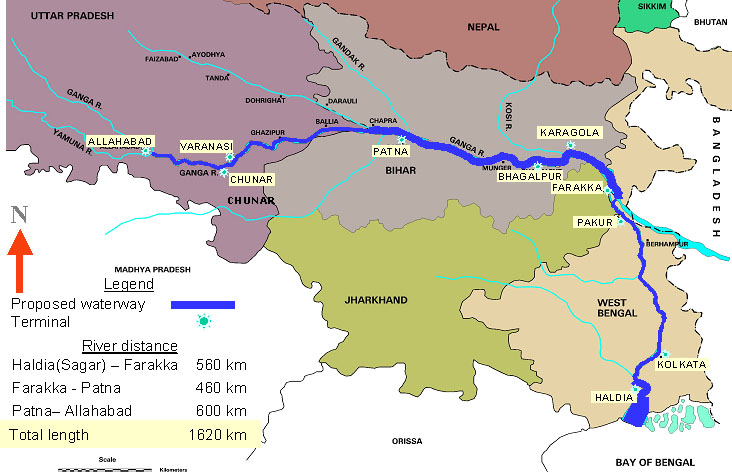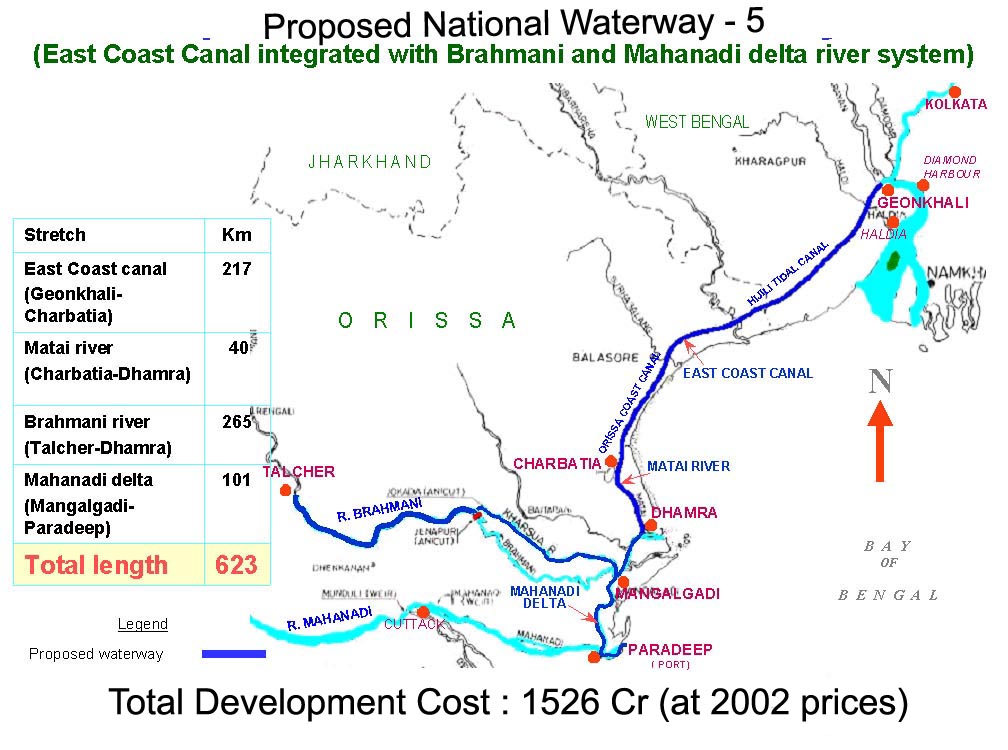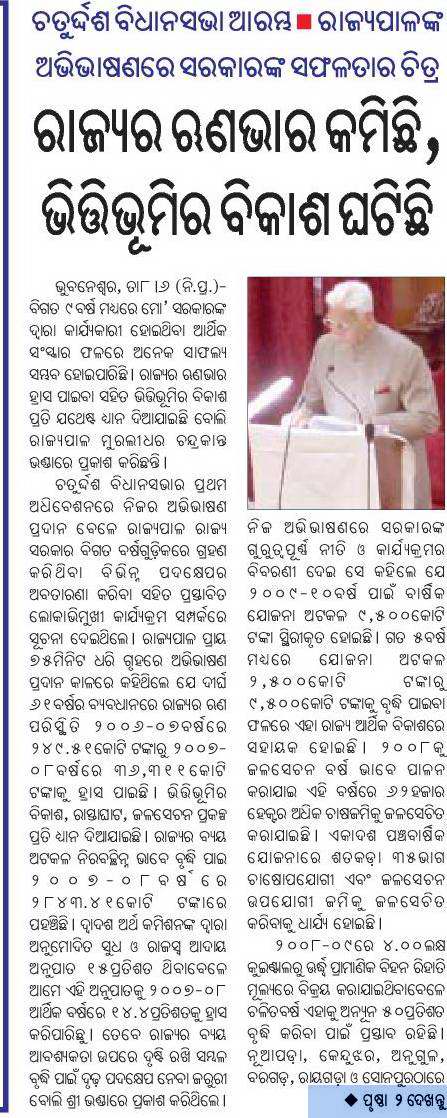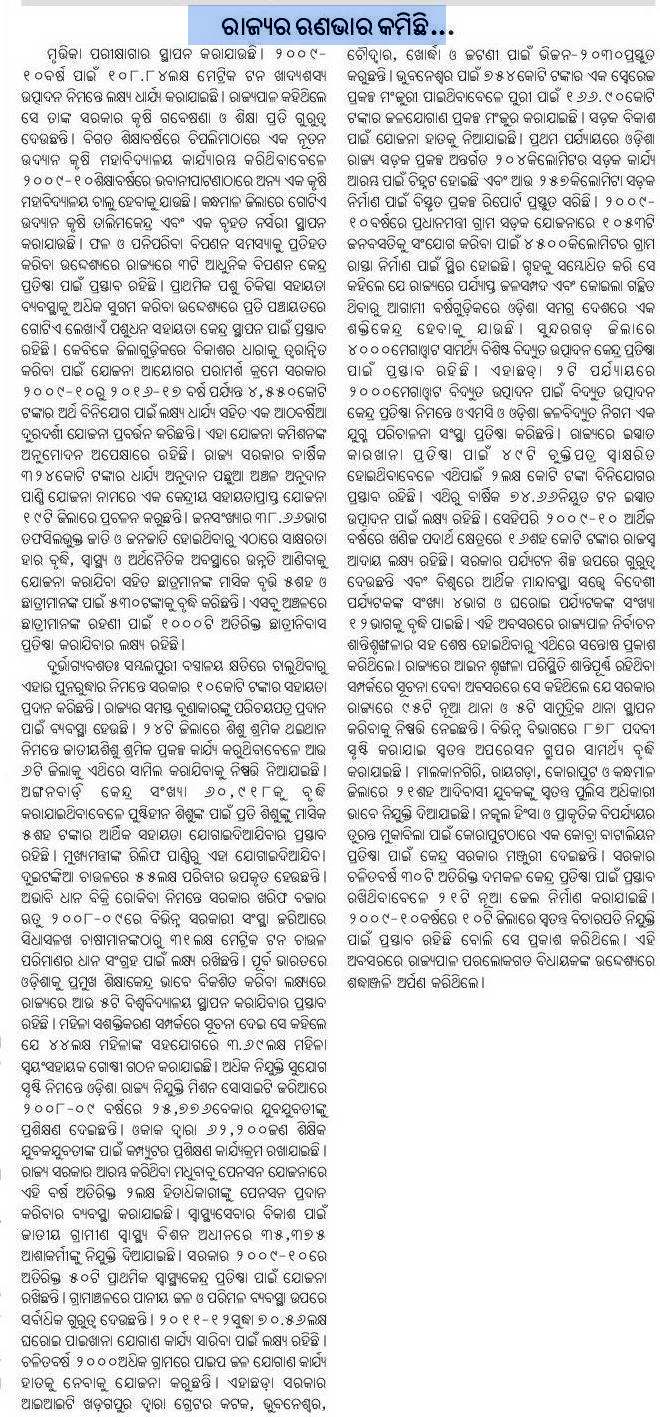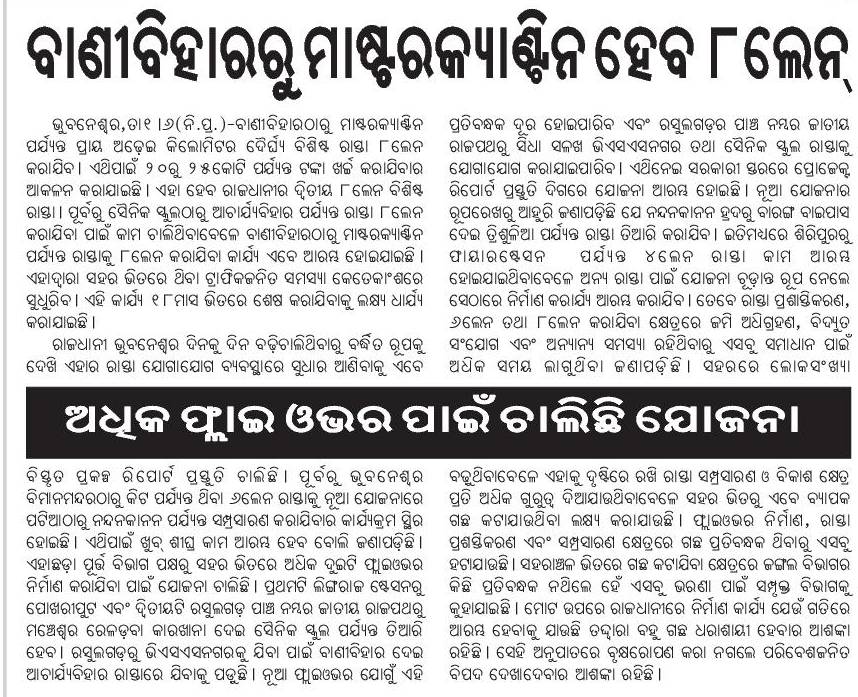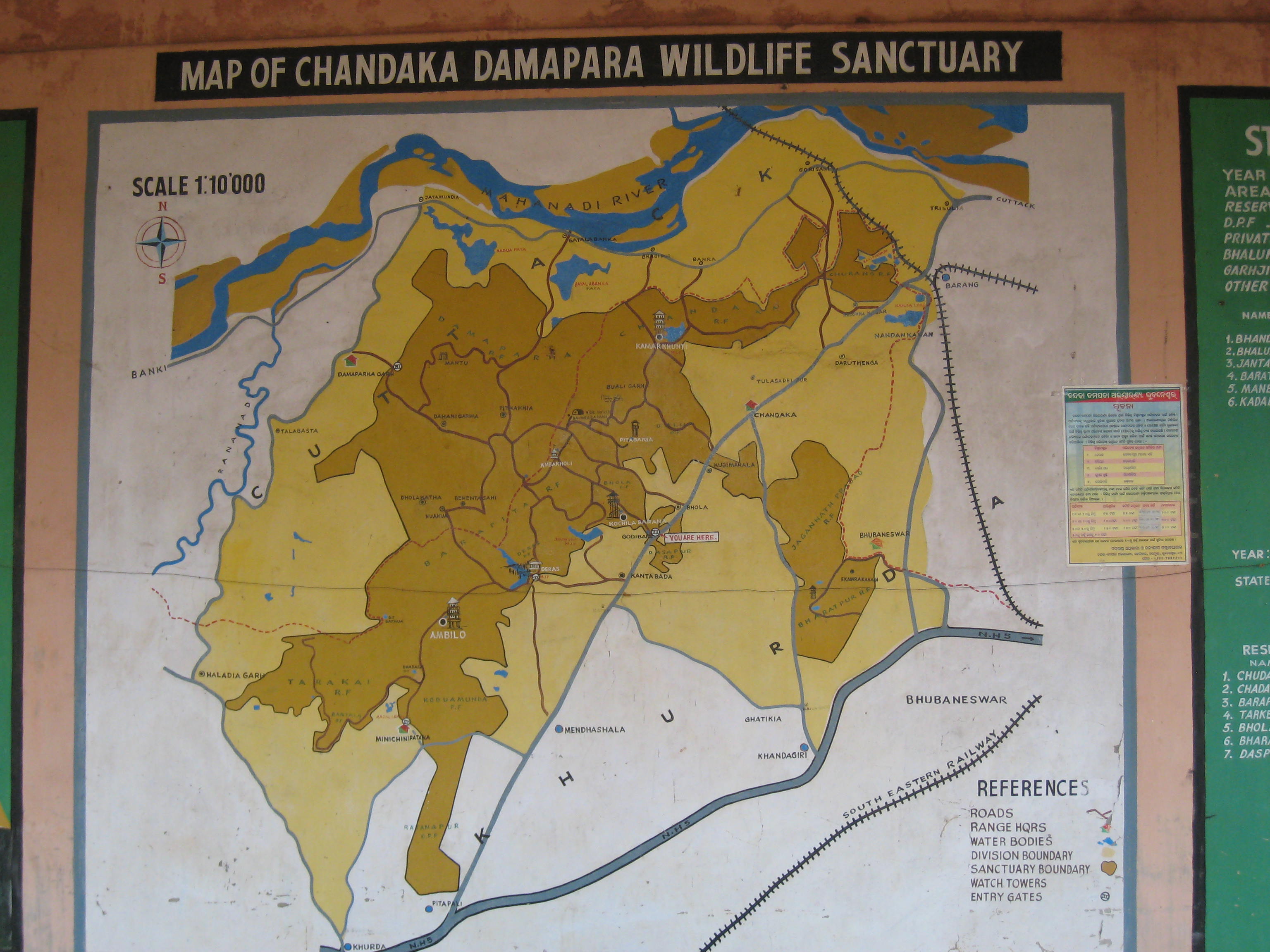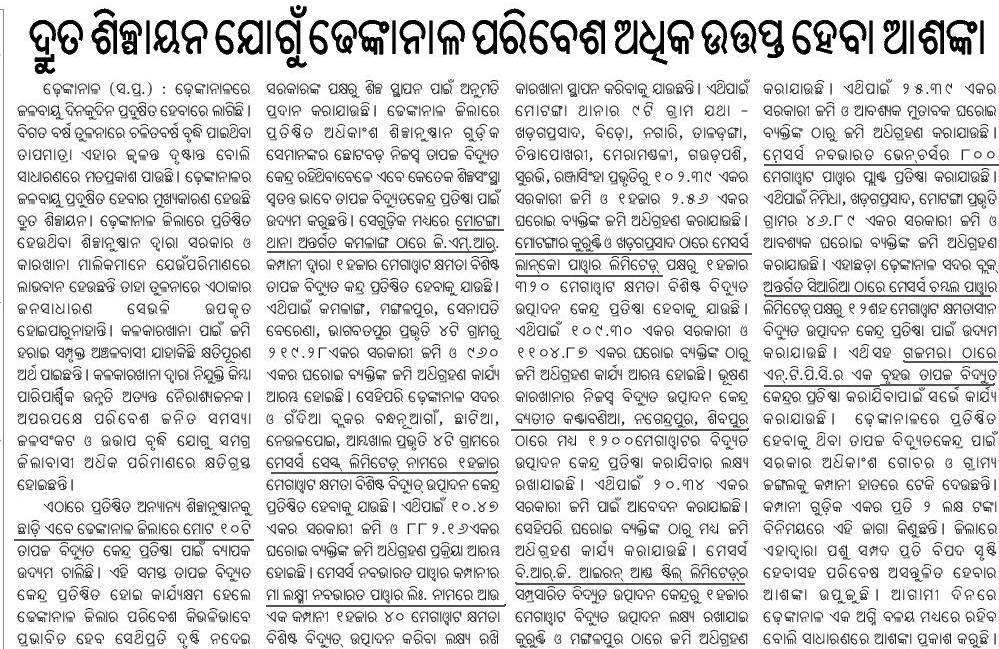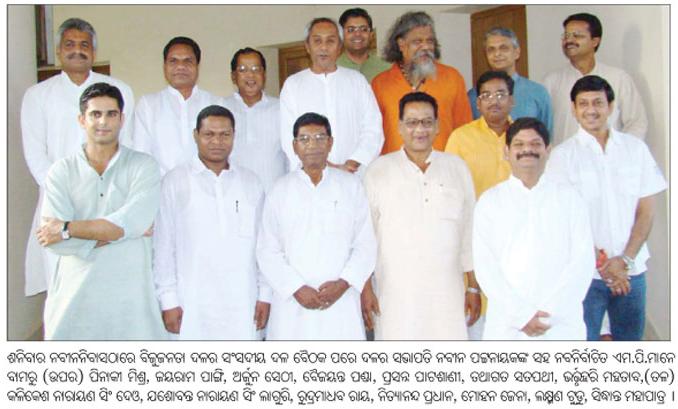India needs an inclusive national alternative to Congress; BJP can reinvent to be that, but it needs to drastically change its track
In some of my earlier postings, I mentioned this. See the following:
- http://www.orissalinks.com/orissagrowth/archives/2429
- http://www.orissalinks.com/orissagrowth/archives/2349
- http://www.orissalinks.com/orissagrowth/archives/2309
Now many others have similar thoughts, including some of the insiders and some people from the Sangh Parivaar. Here is a sample.
- Vaidya of RSS : "the BJP has failed to convey the real meaning of ‘Hindutva’ to the people (in the recent elections). Probably, they thought they were not deemed to climb the pedestal of power with ‘Hindutva’ line. Hence, BJP should now disassociate itself with ‘Hindutva’." … He said BJP mentioned ‘Hindutva’ in its election manifesto in recent Lok Sabha elections but it "miserably failed to attract" the common voters and citizens in the country".
- Vir Sanghvi – The middle class has rejected BJP’s definition of Indianness: "…A new middle class did emerge. It did reject the Nehruvian consensus. It did embrace conspicuous consumption. And yes, it clasped the BJP to its collective bosom. The party, which had hovered around the fringes of national politics for decades in various guises, suddenly became the party of a certain kind of educated Indian. The new BJP pandered to middle class sentiment, to middle class prejudice and to middle class grievances. By 2002 or so, things had got to the stage where history books were being re-written, where Jawaharlal Nehru was being routinely derided as the man responsible for India’s poverty, and where L.K. Advani could confidently proclaim that the BJP was now the natural party of governance. And yet, just seven years later, the party seems to be over. …
what happened to the new middle class and its affinity with the BJP? Over the last five years, prosperity has actually increased. And yet, the rejection of the Nehruvian consensus has tapered off. Nor do the issues that once defined the new middle class now seem to matter that much.
We see this most clearly in the change in the middle class approach to the Hindu-Muslim issue. In the 1980s, the BJP built on Hindu anger. It said that Hindus had been humiliated by Sikhs in the Punjab. Now, they were faced with fanatical Muslims who refused to return the sacred birthplace of Ram, preferring to protect a mosque that was itself a symbol of Hindu humiliation. Worst of all, the secular Congress was backing Muslims against Hindus. …
Because that approach worked for so many years, the BJP tried a variation at this election. Hindus were being attacked by Muslim terrorists. These terrorists could easily be locked up but the Congress refused to re-impose POTA for fear of losing Muslim votes. But this time, the middle class paid no attention. And as for the whole Ayodhya issue, middle class voters seemed embarrassed that in the 21st century they should be asked to debate India’s future on the basis of a dispute over a medieval mosque.
We see the change in the way the middle class has rejected the BJP’s definition of Indianness. In 2004, Sushma Swaraj was able to go on TV to declare that she would shave her head in protest if a foreigner became Prime Minister. Now, nobody cares about the foreign origin issue. When you watch TV footage of Sushma’s outburst today, she just seems silly and overwrought. So it is with ‘Indian culture’. The last BJP government demanded that DD newsreaders increase the sleeve-lengths of their blouses and routinely denounced MTV. Throughout the BJP’s term in office, cinema halls were regularly attacked and film shootings disrupted on the grounds that Indian culture was being undermined.
Now, when the Ram Sene attacks women for going to pubs or the lunatic fringe of the Parivar tries to disrupt Valentine’s Day, the protests come from the entire middle class. Nor are the attacks on cinema halland film crews that common. For instance, Deepa Mehta could easily shoot Water in today’s India. …
Nowhere is the transformation clearer than in the attitude to Narendra Modi. I accept that most middle-class people do not necessarily regard him as a mass murderer in the way that I do. But equally, you cannot deny that his brand of hate-filled demagoguery makes the middle class nervous.
People want stability even more than they want development. They do not want the politics of hate and communal tension. And at some level, they are embarrassed by the way the world looks at us after the Gujarat riots and by Modi’s pariah status in many Western countries. What’s made the difference? Here’s my theory. I reckon that the middle class today is more homogenous and more mature than it was even five years ago. The new middle class has lost its sense of grievance; it has lost the outsider’s desire to overturn the ruling consensus; and it has gone past the issues on which the BJP’s appeal is based.
- Sudheendra Kulkarni in Tehelka: "… Why did the BJP invite this weakness upon itself? The reason has to do with the widespread ideological confusion within the party over what the BJP’s advocacy of Hindutva actually means. The confusion has persisted for a long time, but it intensified after the defeat of the BJP/NDA in 2004. There was a strong view within a section of the party — and a much stronger and almost unanimous view within the larger Sangh Parivar — that the Vajpayee’s government was defeated because the BJP had “abandoned Hindutva”. The argument went like this: “In its bid to form the NDA government, the BJP kept aside its core ideological commitments on the construction of the Ram Temple in Ayodhya, the abrogation of Article 370 and the Uniform Civil Code. The Hindu voters, who had enabled the BJP to emerge as a strong force in Indian politics in the late 1980s and 1990s, felt let down by this. In 2004, the BJP again kept the Hindutva issues in cold storage and made development its main plank. This further disillusioned the Hindu voters. Their indifference led to the party’s defeat in 2004.” In the aftermath of the setback in 2009, many angry voices have again blamed the party leadership, Advani in particular, for the same reason — “You lost because you abandoned Hindutva.” t’s a deeply flawed view. It errs in believing that the BJP’s Hindu base is synonymous with the totality of Hindu voters. The fact is, Hindus never vote as a block for any particular party. There is only a small section of Hindus who have voted as Hindus for what they perceived as a pro-Hindu party — the Jana Sangh in the past and the BJP in later years. Their number increased dramatically in the late 1980s and early 1990s due to the Ayodhya movement, which, for about ten years, caught the imagination of a large section of the Hindu society. However, the BJP’s rising strength in the late 1990s was also on account of another important factor, which had nothing “Hindu” about it: the people’s desire to give the BJP also an opportunity to govern the country. This desire was further whetted by Vajpayee’s pan-Indian popularity, as was evident from the appeal of the slogan “Sabko dekha baari baari, Ab ki baari Atal Behari”.
If the BJP’s electoral success in 1998 and 1999 was due to factors beyond what are narrowly seen as “Hindutva” issues, subsequent events have proved beyond a shadow of doubt that the party’s Hindu base is small even within Hindu society, not to speak of the electorate as a whole. This small Hindu base on its own can never bring the party to power at the Centre. … At a broader level, it is high time the BJP seriously debated and decided what it means by ‘Hindutva’, and also what formulations of ‘Hindutva’ are not acceptable to it. True, the BJP must remain an ideology-driven party. But without clarity on what the BJP’s ideology is, the party cannot win the support of more Hindus, let alone the support of Muslims and Christians. Understood as ‘Cultural Nationalism’ in an inclusive, integrative and noncommunal sense, Hindutva indeed defines the organizing and sustaining principle of the Indian Nation. However, just as the noble principle of secularism can be perverted and practiced for politically expedient reasons — the selfstyled ‘secular’ parties have indeed done it to isolate the BJP — Hindutva is also vulnerable to narrow interpretations and bigoted practice. …
- Pratap Bhanu Mehta – Party of little men: "… This is a real shame, because India needs a good Opposition party. It also needs a sensible conversation about many of the issues the BJP raised before it completely lost track of what it stood for. But all the recipes being proposed: the BJP should ideologically reinvent itself, it should jettison the RSS, it should be forward looking, face one obstacle. Who will bell the cat? Is there any leader amongst this lot who has the minimal credibility to take the party in any direction?"
- Sundeep Dougal’s roundup at http://blogs.outlookindia.com/default.aspx?ddm=10&pid=1896&eid=5
- Kingshuk Nag in Times of India.
Talcher FCI revival; a good first step for Srikant Jena but he needs to get the Paradeep PCPIR approved and establish a NIPER in Orissa
Following is from Samaja:
Following is from a report in Economic Times:
Union minister of state for chemicals and fertilizer, Srikant Jena on Sunday said the fertilizer plant at Talcher, 126 km from here would be revived with an investment
of Rs 12,000 crore. It provided direct and indirect employment to 30000 people in the area.
“The government will appoint consultants to suggest the modalities to raise finance, identify appropriate technology to revive the closed fertiliser unit at Talcher”, Mr Jena told ET.
The union government already had decided to revive Talcher plant. In fact, last October the Cabinet had set up an Empowered Committee of Secretaries under the chairmanship of Fertiliser Secretary Atul Chaturvedi to come up with possible financial models for the revival of the closed plants at Talcher, Barauni, Haldia, Ramagundam, Durgapur, Gorakhpur, Korba and Sindri.
The Talcher plant had liabilities of over Rs 4000 crore and assets worth of Rs 225 crore. “The liabilities comprise of mostly loans from the government of India and interest on loans. This can be waived once all the modalities of revival are worked out. We propose to expand its capacity to 12 million ton per annum [TPA].
Commercial production of Ammonia and Urea at the Talcher unit commenced in November 1980. Urea and Ammonia plants have been designed with a capacity to produce 4.95 lakh and 2.97 lakh tpa respectively.
However production of Urea and Ammonia was first suspended from April 1, 1999 due to its economic non-viability. In 2002, it came to grinding halt after the NDA government decided to close the unit following BIFR sanction.
Last year, the union government decided to renew Talcher unit and consulted with the companies like the Rashtriya Chemicals and Fertilisers and National Fertilisers. It even decided to put in an investment of Rs 5,000 crore in the project in view of the ambitious target of production of 40 million tpa of urea by 2012.
… RCF is the only profit making public sector fertilizer company which has evinced interest to take over Talcher and Durgapur (West Bengal) Fertilizer plant for revival. In fact, the feasibility report on Talcher had already been submitted to RCF.
The revival plan included proposal to convert Talcher plant from a coal based urea plant to a gas-based urea unit with capacity to produce 2000 ton of ammonia per day. There is no problem of water in Talcher, non-availabilty of gas remains the biggest hurdle in the way of reviving the plant. There is no source of gas nearby.
The proposed gas pipe line to be laid by Reliance Industries carrying gas from Krishna-Godavari basin to West Bengal via Bhadrak in Orissa could be the solution, sources said. However, the ministry will take a final view after the consultants submit detailed report on the financial model and technological options available for the revival of the Talcher unit.
Following is from a report in Pioneer:
Union Minister of State for Chemicals and Fertilisers Srikant Jena has to push a few major projects for Orissa, feel industry watchers. One of the largest projects waiting for clearance is the Petroleum, Chemical and Petrochemical Investment Region (PCPIR) project at Paradip.
The State Government has proposed a PCPIR expecting an investment of Rs 2.75 lakh crore.
While PCPIRs have been approved for Gujarat, Andhra Pradesh and West Bengal, the fate of Orissa’s proposal for it is still hanging. The PCPIR policy, notified in April 2007, seeks to ensure adoption of a holistic approach to the development of global scale industrial clusters in the petroleum, chemical and petrochemical sectors in an integrated and environment-friendly manner.
The Government of Orissa has taken the Indian Oil Corporation Limited (IOCL) as the anchor investor. The IOCL is investing nearly Rs 30,000 crore for a greenfield refinery project at Paradip. The PCPIR proposal is, however, gathering dust in the files of the Ministry. So, it is high time Jena pushed the project to the Union Cabinet for approval by convincing the Cabinet-rank Minister MK Ajhagiri.
With this single clearance, Paradip will be in a position to attract huge investments in the petroleum, petrochemicals, fertilisers and other related areas. Similarly, Jena can push for the establishment of a NIPER (National Institute of Pharmaceutical Education and Research) in Orissa.
Orissa’s debt burden is at 50,000 crores now: Samaja
I think the fact that the debt has doubled in 10 years is not necessarily a concern. My guess is that the annual budget of Orissa has probably quadrapled during that time. (As a related data point, the planning commission outlay for Orissa was Rs 5105 crores in 2007-08 and is Rs 9500 crores in 2009-10.) That plus the recent debt swap they did to reduce the intetrest rates means the percentage of annual budget going towards debt servicing has reduced. Nevertheless, the government should be concerned about the size of the debt.
Using National Waterways 1 and 5 one can go from Talcher to Allahabad
Maps of National Waterway 1 and 5 are given below.
There is a definite action plan for the construction of National Waterway 1. See details at http://iwai.gov.in/misc/nw1.pdf. It seems a major part of National Waterway 1 is scheduled to finish by 2010. National waterway 5 is a longer project and once it starts it is scheduled to take 8 years. Following is information on the current plans regarding National Waterway 5.
NATIONAL WATERWAYY -5 [EAST COAST CANAL ALONG WITH BRAHMANI RIVER AND MAHANADI DELTA]
The stretches of the waterway (1095 kms) which has been declared as National Waterway (NW) are as follows
- East Coast Canal ( Geonkhali- Charbatia) – 217 km
- Matai river (Charbatia- Dhamra) – 40 km
- River Brahmani (Talcher- Dhamra) – 265 km
- Mahanadi delta rivers (Mangalgadi- Paradip) – 101 km Total 623 km
* The waterway is located in the States of West Bengal (91 km) and Orrissa (532 km)
* For Brahmani- Kharsua-Dhamra River, Matai river and Mahanadi delta portion(406 km), the waterway is proposed to be developed with 45 m wide and 2 m deep navigational channel while for East Coast Canal portion (217 km), with 32 m wide and 1.5 m deep navigational channel.
* Developmental works envisaged are as follows:
- Widening of narrow canal
- Dredging, Excavation
- Bank protection
- Construction of barrages in Brahmani river at 5 places
- Repair of locks
- Modification of bridges & roads
- Navigational aids
- Setting up of IWT terminals (all terminals are in Orissa)
* Estimated Cost of development works (Rs 1526 crore- At 2002 prices)
- Fairway development – 1271(Cost of barrages Rs 900 cr)
- Navigational Aids – 11
- Terminals – 242
- Setting up of office – 2
Total 1526
*The cost given above is at 2002 rates as indicated by the Consultant earlier. They are revising the cost and the current cost is likely to be of the order of Rs 2950-3000 cr as tentatively informed by them
* Period of implementation- 8 years
* Identified cargo- Coal, fertilizer, cement, iron ore, paddy, rice, seeds, coconut, wheat, sugar, edible oils, bamboo, straw, jute, industrial products etc.
Updates on Vedanta operations in Orissa
Following is an excerpt from a report in Economic Times.
As regards Orissa projects, where 80% of the employees are from the state, we have resolved not to go for any layoff. In fact, we are appointing more and more people in our projects here,” Vedanta Group chairman Anil Agarwal told reporters here on Saturday on the sidelines of his first meeting with Orissa chief minister Naveen Patnaik after the latter swept the just concluded polls.
Mr Agarwal claimed that Vedanta had already invested Rs 25,000 crore of its promised Rs 50,000 crore investment in the state. “The rest will be spent in the next two years”, he assured.
Meanwhile, the VAL had secured Stage I clearance for mining of bauxite in Niyamgiri hills to feed its Lanjigarh project. …
Mr Agarwal also stated that Vedanta had got coal block for its Jharsuguda smelter project and it will soon start coal mining. To a query on the University project, Mr Agarwal said: “We are going to start our university project very soon.”
Mr Agarwal hoped that the state government would soon pass the Vedanta University Bill in the Assembly. “We have already submitted all papers to the state government required for passing of the Vedanta University Bill. I hope it will be passed in the House shortly,” he added.
He informed that Anil Agarwal Foundation – which is setting up a world class university at Puri that includes a 1000-bed hospital – will have its extended centre in Bhubaneswar. “During the meeting, the CM was contemplating if we have can have an extended centre of our hospital project in Bhubaneswar to set up a trauma centre for burn and coma patients. We have in fact agreed for it,” he said.
Excerpts from the Presidents’ speech to the new parliament on 4th June 2009
The whole speech is at http://presidentofindia.nic.in/sp040609.html. Following are excerpts. The underlining and other emphasis is mine.
18. The flagship programmes which my Government introduced have moved the country towards inclusive development. It would be our endeavour to consolidate these programmes in the next five years. The National Rural Employment Guarantee Act has proved to be what it promised-an effective social protection measure and the largest programme in the world for rural reconstruction. Its transformational potential is unfolding before our eyes. My Government would enlarge the scope of works permitted under the National Rural Employment Guarantee Act presently limited to unskilled manual work. The opportunity for improving land productivity through the NREGA will be maximized through better convergence of NREGA with other programmes. To ensure transparency and public accountability, independent monitoring and grievance redressal mechanisms will be set up at the district level.
19. The National Rural Health Mission has begun to strengthen rural public health infrastructure. The Mission would be consolidated to make perceptible reduction in infant mortality and maternal mortality in the next five years. Vaccine producing institutes in the public sector will be revived to support the immunization programme. My Government will expand the Rashtriya Swasthya Bima Yojana to cover all families below the poverty line in the next five years. Malnutrition has emerged as a major health challenge needing urgent response. Hence the nutrition delivery programme will be comprehensively revamped to bring it under the watch of panchayat institutions and move to provision of hot cooked meals in anganwadis.
20. Sarva Shiksha Abhiyan has been able to provide access to children to elementary schools and retention has increased on account of the universal mid-day meal programme. The focus will be on making quality education a right through the enactment of the Right to Free and Compulsory Education Bill now under consideration of Parliament. The Madhyamik Shiksha Abhiyan will universalize access to secondary education. The massive expansion in higher education through new institutions under implementation in the Eleventh Plan will enable the country to meet the challenge of education in full measure. In the last five years, a wide range of scholarships and educational loans was introduced for the needy and deserving students. This effort will be reviewed and further strengthened. Government’s strategy for higher education will be formulated around a three-fold objective of expansion, inclusion and excellence. The suggestions given by the National Knowledge Commission will guide the formulation and implementation of the strategy.
21. While male literacy went up to over 75 percent in the last census and is expected to be higher now, female literacy was only 54 percent in 2001. My Government will recast the National Literacy Mission as a National Mission for Female Literacy to make every woman literate in the next five years. Increased female literacy is expected to become a force multiplier for all our social development programmes.
22. My Government launched Bharat Nirman five years ago as a time-bound business plan for rural infrastructure. It has succeeded in reaching basic infrastructure of roads, electricity and telephone to a large number of villages. It has also achieved most of the targets of rural water supply, rural housing and has increased irrigation potential. The remaining tasks will be completed in the second phase of Bharat Nirman. It is also proposed to set enhanced targets for Bharat Nirman in the second phase.
– The Indira Awas Yojana, which exceeded the original target of sixty lakh houses for the period 2004-2009, will now take up double the target of rural housing to one crore twenty lakh houses to be completed in the next five years.
– Rural Water supply programme will be completed by 2011 and handed over to be managed by panchayats in the next Plan.
– The rural telecommunication target will be set at reaching 40% rural teledensity in the next five years and expanding broadband coverage to connect every panchayat to a broadband network in three years. The scheme for Common Service Centres or e-kiosks will be suitably repositioned to be a network of panchayat-level Bharat Nirman Common Service Centres to provide government services to citizens in rural areas.
– New targets would be set for rural electrification, irrigation and road connectivity.
23. The Jawaharlal Nehru National Urban Renewal Mission (JNNURM) with approval of projects of nearly Rs. 50,000 crore in the last four years is reshaping our cities and has been widely welcomed. It will continue to focus on infrastructure, basic services and governance reform and increase support to cities to upgrade public transport. Over 15 lakh houses are under construction for the urban poor. There is a need to focus urban housing programmes on the poor living in slums. My Government proposes to introduce a Rajiv Awas Yojana for the slum dwellers and the urban poor on the lines of the Indira Awas Yojana for the rural poor. The schemes for affordable housing through partnership and the scheme for interest subsidy for urban housing would be dovetailed into the Rajiv Awas Yojana which would extend support under JNNURM to States that are willing to assign property rights to people living in slum areas. My Government’s effort would be to create a slum free India in five years through the Rajiv Awas Yojana.
24. My Government proposes to enact a new law — the National Food Security Act — that will provide a statutory basis for a framework which assures food security for all. Every family below the poverty line in rural as well as urban areas will be entitled, by law, to 25 kilograms of rice or wheat per month at Rs. 3 per kilogram. This legislation will also be used to bring about broader systemic reform in the public distribution system.
26. Over 50 percent of our population is below 25 years of age and their creative energy is our greatest strategic resource. The challenge is to invest in their education, employability and employment. India has the capacity to contribute to a fourth of the global work force if it invests in skill development of its youth. Education which provides employable skills holds the key for equal opportunities for Other Backward Classes, Scheduled Castes, Scheduled Tribes, and Minorities. My Government has in the last five years brought in legal changes and investment in this direction. These would be consolidated. Besides making massive investment in education, government will focus on the national skill development initiative that has commenced operation with the very ambitious goal of creation of 500 million skilled people by 2022 so that we realize the demographic dividend.
27. The implementation of the Scheduled Tribes and Other Traditional Forest Dwellers (Recognition of Forest Rights) Act would be monitored to ensure that all title deeds are distributed by end of 2009.
29. The Amendment Bill to the Land Acquisition Act and the Rehabilitation and Resettlement Bill prepared to protect farmers and others dependent on farming from unfair displacement and which was placed before Parliament could not be carried through. It will be our endeavour to have these bills reintroduced and enacted in the budget session of Parliament.
30. My Government considerably enhanced provisions for social security through old age pension for all people below the poverty line and above 65 years of age, all handicapped people and all widows above the age of forty. It will examine extending social protection to other persons at special risk. Social security schemes for other occupations like landless labour, weavers, fisherfolk, toddy tappers, leather workers, plantation labour, construction labour, mine workers and beedi workers will be appropriately expanded.
32. My Government will initiate steps within the next hundred days on the following measures:
…
– Restructuring the Backward Regions Grant Fund, which overlaps with other development investment, to focus on decentralized planning and capacity building of elected panchayat representatives. The next three years would be devoted to training panchayat raj functionaries in administering flagship programmes;
– A public data policy to place all information covering non-strategic areas in the public domain. It would help citizens to challenge the data and engage directly in governance reform;
– Increasing transparency and public accountability of NREGA by enforcing social audit and ensuring grievance redressal by setting up district level ombudsman;
– Strengthening Right to Information by suitably amending the law to provide for disclosure by government in all non-strategic areas;
– Strengthening public accountability of flagship programmes by the creation of an Independent Evaluation Office at an arm’s distance from the government catalysed by the Planning Commission. It would work on a network model by collaborating with leading social science research organizations and concurrently evaluate the impact of flagship programmes and place it in the public domain;
– Establishing mechanisms for performance monitoring and performance evaluation in government on a regular basis;
– Five Annual Reports to be presented by government as Reports to the People on Education, Health, Employment, Environment and Infrastructure to generate a national debate;
– Facilitating a Voluntary Technical Corps of professionals in all urban areas through JNNURM to support city development activities;
– Enabling non government organisations in the area of development action seeking government support through a web-based transaction on a government portal in which the status of the application will be transparently monitorable;
– Provision of scholarships and social security schemes through accounts in post offices and banks and phased transition to smart cards;
– Revamping of banks and post offices to become outreach units for financial inclusion complemented by business correspondents aided by technology;
– Electronic governance through Bharat Nirman common service centres in all panchayats in the next three years;
– A model Public Services Law, that covers functionaries providing important social services like education, health, rural development etc. and commits them to their duties, will be drawn up in consultation with states;
– A National Council for Human Resources in Health as an overarching regulatory body for the health sector to reform the current regulatory framework and enhance supply of skilled personnel;
– A National Council for Higher Education as recommended by the Yashpal Committee and the National Knowledge Commission to bring in reform of regulatory institutions;
– Develop a "brain gain" policy to attract talent from all over the world into the 14 universities proposed in the 11th plan to position them as "Innovation Universities";
– A roadmap for judicial reform to be outlined in six months and implemented in a time-bound manner;
– Targeted identification cards would subsume and replace omnibus Below Poverty Line (BPL) list. NREGA has a job card and the proposed Food Security Act would also create a new card. Identification of beneficiaries for other programmes which currently use the omnibus BPL list would improve identification based on programme objectives with the common underlying principle that all identification of beneficiaries will be done through gram sabhas and urban local bodies and the list placed in the public domain to be open to challenge;
– A Delivery Monitoring Unit in the Prime Minister’s Office to monitor flagship programmes and iconic projects and report on their status publicly;
– Suitably institutionalized quarterly reporting on Flagship programmes as "Bharat Nirman Quarterly Reports" where Ministers would publicly report on progress through the media.
33. Infrastructure is a fundamental enabler for a modern economy and infrastructure development will be a key focus area for the next five years. Public investment in infrastructure is of paramount importance. Bottlenecks and delays in implementation of infrastructure projects because of policies and procedures, especially in railways, power, highways, ports, airports and rural telecom will be systematically removed. Public-private partnership (PPP) projects are a key element of the strategy. A large number of PPP projects in different areas currently awaiting government approval would be cleared expeditiously. The regulatory and legal framework for PPPs would be made more investment friendly. My Government will continue its special emphasis on infrastructure development in the North-East and Jammu and Kashmir and enhance connectivity to these regions.
34. Our fellow citizens have every right to own part of the shares of public sector companies while the government retains majority shareholding and control. My Government will develop a roadmap for listing and people-ownership of public sector undertakings while ensuring that government equity does not fall below 51 %.
35. My Government is firmly committed to maintaining high growth with low inflation, particularly in relation to prices of essential agricultural and industrial commodities. It will steadfastly observe fiscal responsibility so that the ability of the Centre to invest in essential social and economic infrastructure is continuously enhanced. This will require that all subsidies reach only the truly needy and poor sections of our society. A national consensus will be created on this issue and necessary policy changes implemented.
36. My Government has been able to significantly increase realization of direct taxes as a result of improved and simplified tax administration and this process will continue. The roadmap for moving towards a Goods and Services Tax will be vigorously pursued. My Government is fully seized of the issue of illegal money of Indian citizens outside the country in secret bank accounts. It will vigorously pursue all necessary steps in coordination with the countries concerned.
37. Coordinated action for energy would be guided by the integrated energy policy. The effort would be to see that at least 13,000 MW of generating capacity is added each year through a mix of sources -coal, hydel, nuclear and renewables. Village and rural household electrification and reduction in aggregate technical and commercial losses will continue to be given the highest priority. Competitiveness and efficiency in the power sector will be enhanced through time-bound measures, including operationalising the provision of open access.
38. The pace of oil and gas exploration will be intensified and India’s oil diplomacy aggressively pursued. Reforms in the coal sector, for which a detailed blueprint has been prepared, will be pursued with urgency. The international civil nuclear agreements will be operationalised with various countries even as domestic sources of uranium are exploited and work continues on the indigenously designed fast breeder and thorium reactors.
39. My Government will ensure that our space programme which has achieved wide recognition continues to bring rich dividends to society in agriculture, tele-medicine, tele-education and by providing information to rural knowledge centres, besides contributing to telecommunication, television broadcasting and weather forecasting. Several innovative initiatives commenced by government in the science and technology sector in the last five years and now under implementation will be further strengthened.
40. My Government is proactively addressing issues of climate change through eight national missions. Of these the National Solar Mission, the National Water Mission, the National Mission on Energy Efficiency, the National Mission on Sustainable Agriculture and the National Mission on Sustainable Habitat will be launched by the end of this year. The National Ganga River Basin Authority, set up recently will evolve a new action plan for cleaning and beautifying the river in partnership with the basin states.
Bhavna Pani is Bharati in “Bharati: the wonder that is India”
Bharati: the wonder that is India is a musical extravaganza that is touring in various countries, mostly in Europe. Following is what their web page says about the show.
‘Bharati’ is a musical extravaganza, a delectable composite mix of the varied dances, music and folk traditions of India. Over the space of 90 minutes, the audience is guided through a brief but scintillating sampling of India’s rich and breath-taking diversity. Though just a glimpse, the selections hint at the hidden treasures of this vast and enchanting land; its regional, linguistic, historical and philosophical diversity; its myriad peoples, life-styles and traditions.
Due to continuous reinvention and renewal, these traditions appear to be in a state of constant flux. A taste of this infinite variety is offered in a show that is at once entertaining and intriguing. In making the selection, one of the guiding principles has been the search for elements with enduring appeal.
Music, dance and performance traditions have shaped the ‘collective consciousness’ of the Indian diaspora worldwide, and kept India alive in its collective imagination. Ingredients of popular culture have served as inspiration and link to Indian traditions and heritage. This show is at once a celebration of the vitality of these traditions and an invitation to sample and participate in their unique energy.
The namesake role of the show (Bharati) is done by Bhavna Pani from Orissa. Her introduction in their web page is as follows:
Bhavna was trained in the Odissi Classical dance school under Gurus Mahapatra and Attibudhi. Has won the All India Dance Competition and the Sringar Title (2001) by Sur Sringar Samsad. Danced at the Terrence Lewis Contemporary Dance Company and included performing in many stage productions Featured in films (Vettam, Yuvaraja, Tere Liye.) and TV Commercials.
Following are some youtube clips of the show.
BHEL second unit to open in Trichy
Following is an excerpt from a report in Business Standard.
Prime Minister Manmohan Singh is likely to inaugurate the second unit of state-run Bharat Heavy Electricals Ltd (BHEL) in Tiruchirapalli by the end of this month, a top company official said here today.
"The Rs 750 crore plant is ready and we are waiting for dates from the Prime Minister’s Office to confirm his visit to Tiruchirapalli to inaugurate the plant," BHEL Tiruchirapalli complex Executive Director V Ananthakrishnan told reporters here.
"Already we are recruiting 1,000 candidates per year and this year too we will recruit another 1000," he said, adding they would continue to recruit candidates at the same pace over the next three years.
Orissa should make efforts to have similar non-metal processing and non-thermal power related public sector units in Orissa.
Road broadening plans for Bhubaneswar – Samaja
Following are some of the items mentioned in the article below:
- The 2.5 km from Vani Vihar to Master Canteen will be made 8 lanes. (Janpath from NH 5 to Mahatma Gandhi marg) This will be the second 8 lane segment in Bhubaneswar after the Sainik School to Acharya Vihar segment. (Sachivalaya marg from NH 5 to Sainik School)
- The six lane road from airport to KIIT will be extended all the way up to Nandan Kanan.
- A flyover from Lingaraj station to Pokhariput is planned.
- Another flyover from Rasulgarh to Sainiki School via Mancheswar Railway workshop and VSS Nagar is planned.
- A road from Nandan Kanan Lake to Trishulia through Barang bypass
- Fourlaning from Siripur to Fire station (Azad marg)
An afternoon-evening trip to Chandaka-Dampada Sanctuary
I finally decided to visit the Chandaka-Dampada Sanctuary which is adjacent to Bhubaneswar. We entered the sanctuary through the Godibari gate.
.jpg)
.jpg)
The above sign was visible from the road.
.jpg)
The above is the outer gate to the sanctuary.
.jpg)
The inner gate is beautifully made.
.jpg)
As soon as you enter the gate the above is the view of the forest with a dirt road bisecting it.
.jpg)
Looking back at the gate one can see the moat and the mechanism to prevent the elephants to get out. However, the elephants do get in and out of the sanctuary through other gaps in the boundary moat.
.jpg)
The dirt road has signs to a few destination points; the first one being the Kumar Khunti watch tower.
.jpg)
On the way we pass through an old structure that was part of the fort of the local king.
.jpg)
The above is the view from the top of a watch tower looking towards the dirt road that took us there.
.jpg)
In the other direction there is a lake.
.jpg)
.jpg)
About 100 yards from the watch tower there is a man made salt mound to attract the elephants.
.jpg)
.jpg)
The watch tower is a four story structure with two bed rooms in each of the second and third floors. Guests can stay there overnight. We peeked at the bath room. They looked clean. Near the watch tower there are huts where some staffs stay. The staff bring water to the watch tower rooms and cook food for guests.
.jpg)
The above is a closer view of the salt mound.
.jpg)
Ambilo watchtower and Dampara gate are two other landmarks. Note the distance; 20 kms of forest road to the Ambilo watch tower. The whole sanctuary is 193 sq kms, almost as big as present day Bhubaneswar city limits.
.jpg)
.jpg)
With the dirt road giving us the view of only a very small part of the forest we did not see many animals. Above we saw a few jungle fowls.
.jpg)
.jpg)
We also saw a few jungle peacocks.
.jpg)
This is the lake made due to the Deras dam.
.jpg)
Near the lake there were nicer guest houses. The elephants don’t come here. Hence they are not elephant proof.
.jpg)
.jpg)
The view of the Deras lake is beautiful. But it was getting dark. So I could not take very many pictures.
.jpg)
As it was getting dark and we did not have plans to make an overnight stay, we could not visit the Ambilo tower. We got out through the Kantabada gate which is near the Dearas dam.
Rourkela MLA and minister of state is in the right track; time for a CDP and a greater Rourkela
Following is an excerpt from a report in Expressbuzz.com.
Minister of State (independent charge) for Food Supplies and Consumer Welfare Sarada Prasad Nayak today outlined his plans for all-round development of his home city Rourkela by including it in the Comprehensive Development Plan (CDP).
Addressing mediapersons here, Nayak spoke about formation of greater Rourkela by including suburban pockets like Kalunga, Vedvyas and Fertiliser Township under the Central Government funded CDP. He said if everything goes as expected, in three years the Steel City would get a facelift with a fresh sewerage system, solid waste management project and rehabilitation of slum-dwellers on a 30-acre land. …
State Level Single Window Clearance Authority (SLSWCA) clears many projects
Following is an excerpt from a report in Business Standard.
The State Level Single Window Clearance Authority (SLSWCA) headed by the chief secretary Ajit Kumar Tripathy today cleared five projects worth Rs 2807.7 crore.
…out of the 12 proposals considered by SLSWCA, the proposal of Bhubneswar Power Private Ltd for setting up of a 2X67.5 Mw CPP was deferred. The energy department has been asked to consider the proposal from the policy point of view.
Two major investment proposals by Vedanta Aluminium Ltd (VAL) and Hindalco Industries were partially approved in today’s meeting due to non-availability of bauxite and pending the environmental carrying capacity study by the Orissa State Pollution Control Board.
VAL had proposed to expand the capacity of its refinery at Lanjigarh from one million tonne per annum (MTPA) to 6 MTPA and the smelter plant capacity from 0.25 MTPA to 1.6 MTPA. Besides, the capacity of the CPP was proposed to be raised from 674 Mw to 1350 Mw with a combined investment of Rs 37,440 crore.
The company had signed MoU with the Orissa government for the present capacity at an investment of Rs 12,400 crore. However, SLSWCA only recommended for a smelter capacity of 0.5 MTPA as the company had already achieved this level. It also approved the capacity expansion of the CPP to 1350 Mw as sought by the company. The additional smelting capacity will be considered only after ascertaining the availability of bauxite and receipt of the OSPCB study on environment. Similarly, Hindalco Industries Ltd (Aditya Aluminium) had proposed to expand its alumina refinery capacity to 1.5 MTPA from 1 MTPA at present.
Along with this, the company also sought expansion of its smelting capacity to 0.72 MTPA from 0.26 MTPA and increase in the CPP capacity to 1650Mw from 650 Mw.
SLSWCA has decided to recommend a marginal increase in the smelting capacity from 0.26 MTPA to 0.36 MTPA and CPP capacity from 650 Mw to 950 Mw to the HLCA.
It also put conditional approval to the proposal of the Tata Sponge Iron Ltd. to set up a 1.5 MTPA steel making capacity along with a 52 Mw CPP at an investment of Rs 3101 crore. While the existing sponge capacity of the company is 0.39 MTPA, it had sought to expand its capacity by 0.45 MTPA to 0.84 MTPA.
Similarly, the company proposed to set up one MTPA blast furnace and 1.6 MTPA pellet plant in a separate location in Keonjhar district. It will have to increase the steel making capacity first and after that the increase in the sponge making capacity will be allowed.
The other projects which were approved include 4 MTPA iron ore beneficiation plant at an investment of Rs 360.85 crore to be set up by Kolkata based Rashmi Metaliks at Nayagarh in Keonjhar district.
Similarly, the Rs 624.7 crore investment proposal of Rungta mines, Shyam Steel Industries proposal for setting up 2 MTPA iron ore pelletisation plant were cleared by the SLSWCA. Besides, the Toshali Cement’s proposal to expand its capacity to 2100 tonne per day from 600 tonne per day along with 3.96 lakh tonne per annum grinding unit at Choudwar was also approved.
The proposal of Orissa Thermal Power Corporation, a joint venture between Orissa Hydro Power Corporation (OHPC) and Orissa Mining Corporation (OMC) to set up 2000 MW power plant at Rengali at an investment of Rs 8250 crore also received the nod of the committee.
Jindal India Thermal Power’s proposal to increase the capacity from 1200 Mw to 1800 mw and Lanco Bhawan Power’s proposal to increase its capacity to 2640 Mw from 1230 Mw were approved for recommendation to the HLCA on the basis of strong recommendation of the energy department.
In another significant decision, SLSWCA decided not to allow any more cement plant in the state except Malkangiri district as the state does not have sufficient amount of limestone.
Orissa (outside of Kandhamal) voters not fooled by hatemongers; unfortunately that is not the case in Mumbai and Bangalore
Update: JD-U is wising up in Bihar and Jharkhand. As I mentioned before, unless BJP changes track, its fate in many other states will be like its fate in Orissa. Personally, I would like a proper national alternative to Congress. Thus I hope BJP will learn from its mistakes and take a hint from what its few allies like JD-U are saying.
Following is an excerpt from a report in Times of India.
The JD(U) on Saturday launched an attack on BJP for facilitating Congress’s victory in the Lok Sabha polls by raising Hindutva issues rather than focusing on issues that had to do with the common man.
The party identified Varun Gandhi’s alleged hate speech and the sudden insertion of Gujarat chief minister Narendra Modi in the campaign frame as BJP’s two missteps which allowed Congress to corner victory when it ought to have been on the backfoot for issues like price rise and unemployment.
… The details of the discussion, however, were yet another reminder of the strain in the NDA alliance in Bihar, and reinforced the estimate that a resurgent JD(U), that under Nitish Kumar aspires to rule Bihar on its steam, could be chafing at the partnership with the BJP.
… JD(U) MP N K Singh’s interview where he emphasized that the party shared a commonality with the Congress on the issue of secularism.
The writing is clear for BJP. It can listen to its few remaining allies and become a real national alternative or put its head in the sand and write its own epitaph.
Following is an excerpt from an article in Expressbuzz.com.
After 26/11, it seemed like all of Mumbai had become one, rising above language and religious divides. Had the English media got it all wrong again? Five months later, 22 per cent of Mumbaikars voted for the same man who made his name by having helpless poor North Indians bashed up, supposedly to protect the interests of Marathi-speaking locals. Most of these voters would have otherwise voted for the Sena, another party driven by hate and violence. Together, MNS-Sena votes in Mumbai accounted for more than what the Congress-NCP combine got; the split in their vote led to the victory of the ‘secular’ Congress-NCP in the city (except for Priya Dutt, whose victory margin outstripped the vote tally of the MNS candidate).
After all the hullabaloo about the 1984 Sikh killings, the party universally alleged to have been associated with the killings got voted in. The Congress bagged a remarkable 57.11 per cent in Delhi. The party won in Punjab too, getting almost half the votes. And in Orissa, where Adivasis have been resisting POSCO and other corporate land-grabbers, the man who backed the latter has been given the state on a platter.
Where does all this leave those who have fought for the rule of law, for women’s rights, against the current savage pattern of development? Which of the new MPs will raise these issues in Parliament? The Young Turks? Their fathers never did; why would they? They owe their position to their surnames; in fact, they aren’t Young Turks at all. In Orissa, the BJP almost got wiped out; Abdul Madani fell flat in Kerala. But it’s difficult to accept that Bangalore and Mangalore’s voters ignored the barbaric assault on young women; that lakhs of Mumbaikars endorse Raj Thackeray’s goons.
Manmohan’s 2nd innings also starts with humiliating Orissa
Update: The media coverage of the insult and its reaction is being archived at http://upainsults.orissalinks.com/.
When Manmohan Singh became the PM of India in 2004 one of the first things his government did was shift an announced for National Institute of Sciences (NIS) in Bhubaneswar to Kolkata and when Orissa MPs discussed with him about Orissa’ development he is reported to have replied "Money does not grow in trees." It took Orissa-wide demonstrations and a supreme court case for Dr. Singh to make amends and declare the establishment of a National Institute of Science Education and Research in Bhubaneswar. In 2004 he humiliated Orissa by not having a single minister from Orissa. Eventually he added a minister of state from Orissa. Somewhat similar to the NIS case, Dr. Singh’s HRD minister of state had mentioned in a speech in Patna that there will be an IIT in Orissa, but subsequently Orissa was not in the list. Again, after a lot of protests and demonstrations in Orissa, the PM included Orissa as one of the locations of a new IIT.
Fast forward to 2009 and now Congress gets 6 Lok Sabha MPs from Orissa, 4 more than what it had in 2004. Among the 6 MPs is an ex-chief minister and a tribal (Hemanada Biswal) who beat the national vice president of BJP in winning his seat, an ex-cabinet minister of parliamentary affairs and tourism, (Srikant Jena), an ex-minister of state of Railways (Bhakta Das), an ex state minister (Amarnath Pradhan), and two young MPs (one of them a tribal).
It is the PM’s prerogative to chose his team and there is no requirement that there has to be ministers from each state. After all these ministers are supposed to be ministers of all of India and it should not matter where they come from or what their caste is; all that should matter is that they are qualified and they have the PM’s confidence. So objectively one shouldn’t have a problem that he has chosen only one minister of state from Orissa and chosen 3 cabinet ministers and one minister of state from Karnataka, where it got 6 MPs, the same number as Orissa. But the insult to Orissa comes from his demotion to the minister he chose from Orissa. He has picked as a minister of state, not even with independent charge, Mr. Srikant Jena, who was earlier a cabinet minister of India and had Parliamentary affairs and tourism as part of his portfolio. If Dr. Singh did not have confidence in Mr. Jena he need not have picked him. But what is he trying to convey by picking him and giving him a demoted position other than showing his and his party’s continued dislike and insulting attitude towards Orissa.
Dr. Singh: You have won the mandate and I guess like your earlier insult to Orissa when you were reported to have said "Money does not grow in trees", you can do whatever you like. But India is watching and they can see how you continue to insult a state and its people. People of Orissa, including those who recently voted for Congress, are fast losing faith on you and are dreading the next five years, where your ministers will take their booties to their home state.
This is not suppose to happen; your ministers are supposed to look after the whole country and not their own state; but based on the past 5 years, where your ministers have focused less on India as a whole and more on their own states, India’s poorer states, with little representation in your ministry are going to get poorer. For introspection, you may look at your past Railway minister’s boasting about what he did for his home state and compare it with states like Orissa from where it got the most revenue, and what you and your past HRD minister have done for higher education and science and technology for your respective home states.
As per Orissa, it seems like humiliating Orissa is your favorite sport or perhaps your lucky charm, as you seem to be again starting your innings with that.
Reaction from other quarters:
- http://timesofindia.indiatimes.com/India/Naveen-ups-the-ante-over-states-share-in-PM-team/articleshow/4590533.cms.
- http://orissadiary.com/CurrentNews.asp?id=12813.
- http://www.orissadiary.com/ShowOriyaColumn.asp?id=12812.
- http://www.breakingnewsonline.net/2009/05/congress-humiliates-orissa-as-srikant.html.
- http://www.indopia.in/India-usa-uk-news/latest-news/584891/National/1/20/1.
- http://www.tathya.in/2009/story.asp?sno=2972.
- Congress humiliates Orissa again: Expressbuzz.com.
- http://www.indianexpress.com/news/MoS-for-just-Jena-an-insult–says-Orissa-Cong/467123.
- http://dailypioneer.com/179369/Why-Cong-injustice-to-Orissa-continues.html.
- http://dailypioneer.com/179368/UPA-has-neglected-Orissa-again-Naveen.html.
- http://www.business-standard.com/india/news/orissa-neglected-in-upa-ministry-naveen/359452/.
- http://www.orissadiary.com/Shownews.asp?id=12815.
- Orissa peeved: Telegraph.
History of Parlakhemundi light railway: Indian Express
Indian Express has a nice article on the history of Parlakhemundi light railway. Following are some excerpts.
Paralakhemedi Light Railway (PLR) was two feet six inches gauge railway. It was the brainchild of the erstwhile Raja of Paralakhemedi. The Kimedi country, consisting of Paralakhemedi, Paddakimedi and Chinna Kimedi, was under a single ruler till 1607. Paralakhemedi came under the British influence in 1768.
East Coast Railway came into existence in the year 1893 with the construction of the Cuttack-Khurda Road-Puri line, covering a distance of 96 kms and its subsequent link along the East Coast up to Vijayawada — junction point of Southern Maratha Railway and Nizam’s Guaranteed State Railway. As a result, a stretch of 1280 kms of East Coast Railway, covering the entire coastal stretch of Cuttack, Khurda Road, Puri, Palasa, Vizianagaram, Visakhapatnam, Kakinada, Rajahmundry, Vijayawada, was opened for traffic between 1893 to 1896. East Coast Railway brought rail line to Naupada in 1894. The Raja of Paralakhemedi decided to connect his capital with Naupada, which was only 40 kms away. With the government giving sanction in 1898, work began in full earnest. The line was opened to traffic in 1900. This railway line was built at a cost of Rs 7 lakh.
Due to a change in the policy of the British Government, the Bengal Nagpur Railway, popularly known as the B.N.R, took over the northern section of East Coast Railway from Vizianagaram to Cuttack, including the Branch Line of Puri, by 23-01-1902. Accordingly, the working of the PLR was taken over by the Bengal-Nagpur Railway in 1902. In the first few years, the PLR had incurred losses but after 1910, it started making marginal profits and after 1924-25, the profits increased. This motivated the Raja to extend the line to Gunupur in two phases in 1929 and 1931. There were now a total of ten stations between Naupada and Gunupur. Tekkali, Paddasan, Temburu, Ganguvada, Patapatnam, Paralakhemedi, Kashinagar, Lihuri, Bansidhara and Palasingi.
The management of BNR was taken over by the Government of India in October 1944. On 14-04-1952, at the time of the re-grouping of the Indian Railways it became part of the Eastern Railway. The merger of B.N.R. into Eastern Railway, however, did not last long and on 01-08-1955 it was merged with newly constituted South Eastern Railway. During the SER centenary celebrations in 1987, set of four postage stamps were released. One of the stamps featured the PL 691 locomotive.
The standard type of locomotive on PLR was the 20 ton 0-6-4 tank locomotive with small (27 inch diameter) coupled wheels and an axle load of only 4.75 tons. …
The foundation-stone was finally laid for the Naupada-Gunupur gauge conversion work at Naupada on September 27, 2002. With effect from April 1, 2003, PLR became a part of the newly formed East Coast Railway. The line was finally closed for gauge conversion on June 9, 2004.
— VIKAS SINGH, RAIL ENTHUSIAST
Courtesy National Rail Museum
List of central ministers and their portfolio
The following list is based on data from:
- http://www.breakingnewsonline.net/2009/05/team-manmohan-59-ministers-including-14.html.
- http://timesofindia.indiatimes.com/PM-Manmohan-to-head-79-member-Cabinet/articleshow/4583393.cms.
- http://timesofindia.indiatimes.com/Pranab-Mukherjee/quickiearticleshow/4569248.cms.
- http://election.rediff.com/report/2009/may/28/loksabhapoll-new-cabinet-ministers-portfolios.htm.
- http://timesofindia.indiatimes.com/Ghulam-Nabi-to-get-Health-Sibal-to-head-HRD/articleshow/4590151.cms.
| Dr. Manmohan Singh | Assam | Prime Minister, also in charge of Personnel, Public Grievances & Pensions; Ministry of Planning; Department of Atomic Energy; Department of Space; and Ministry of Culture |
| CABINET MINISTERS | ||
| Pranab Mukherjee | West Bengal | Finance |
| P. Chdambaram | Tamil Nadu | Home affairs |
| Sharad Pawar | Maharashtra | Agriculture, Food & Civil Supplies and Consumer Affairs & Public Distribution |
| A K Antony | Kerala | Defense |
| Mamata Banerjee | West Bengal | Railways |
| S M Krishna | Karnataka | External Affairs |
| Ghulam Nabi Azad | J & K | Health & Family Welfare |
| Sushilkumar Shinde | Maharashtra | Power |
| M Veerappa Moily | Karnataka | Law and Justice |
| S Jaipal Reddy | AP | Urban Development |
| Kamal Nath | MP | Surface Transport & Highways |
| Vayalar Ravi | Kerala | Overseas Indian Affairs |
| Meira Kumar | Bihar | Water Resources |
| Murli Deora | Maharashtra | Oil & Petroleum |
| Kapil Sibal | Delhi | Human Resource Development |
| Ambika Soni | Information & Broadcasting | |
| B K Handique | Assam | Mines, Development of North-Eastern Region |
| C P Joshi | Rajasthan | Rural Development & Panchayati Raj |
| Anand Sharma | HP | Commerce & Industry |
| Virbhadra Singh | HP | Steel |
| Vilasrao Deshmukh | Maharashtra | Heavy Industries & Public Enterprises |
| Dr. Farooq Abdullah | J & K | New & Renewable Energy |
| Dayanidhi Maran | Tamil Nadu | Textiles |
| A Raja | Tamil Nadu | IT & Communication |
| Mallikarjun Kharge | Karnataka | Labour & Employment |
| Subodh Kant Sahay | Jharkhand | Food Processing Industries |
| Dr M S Gill | Punjab | Youth Affairs & Sports |
| G K Vasan | Tamil Nadu | Shipping |
| Pawan Kumar Bansal | Chandigarh | Parliamentary Affairs |
| Mukul Wasnik | Maharashtra | Social Justice & Empowerment |
| Kantilal Bhuria | MP | Tribal Affairs |
| M K Azhagiri | Tamil Nadu | Chemical & Fertilisers |
| Kumari Selja | Haryana | Housing, Urban & Poverty Alleviation, Tourism |
| MINISTERS OF STATE WITH INDEPENDENT CHARGE | ||
| Praful Patel | Maharashtra | Civil Aviation |
| Prithviraj Chauhan | Maharashtra | Science & Technology; Earth Sciences and MoS in the Prime Minister’s Office; Personnel, Public Grievances and Pensions and Parliamentary Affairs. |
| Sriprakash Jaiswal | UP | Coal; Statistics & Programme Implementation |
| Salman Khursheed | UP | Corporate Affairs; Minority Affairs |
| Dinsha Patel | Gujarat | Micro, Small and Medium Enterprises |
| Jairam Ramesh | AP | Environment and Forests |
| Smt Krishna Tirath | Delhi | Women and Child Development |
| MINISTERS OF STATE | ||
| E Ahamed | Kerala | Railways |
| V Narayanasamy | Puducherry | Planning and Parliamentary Affairs |
| Srikant Jena | Orissa | Chemicals and Fertilizers |
| Mullappally Ramachandran | Kerala | Home Affairs |
| Smt D Purandeswari | AP | HRD |
| Smt Panabaka Lakshmi | AP | Textiles |
| Ajay Maken | Delhi | Home Affairs |
| K H Muniyappa | Karnataka | Railways |
| Namo Narain Meena | Rajasthan | Finance |
| Jyotiraditya Scindia | MP | Commerce and Industry |
| Jitin Prasad | UP | Petroleum and Natural Gas |
| A Sai Prathap | AP | Steel |
| Gurudas Kamat | Maharashtra | Communications and Information Technology |
| M M Pallam Raju | AP | Defence |
| Mahadev Khandela | MP | Road Transport & Highways |
| Harish Rawat | Uttarakhand | Labour and Employment |
| Professor K V Thomas | Kerala | Agriculture, Consumer Affairs, Food & Public Distribution |
| Saugata Ray | West Bengal | Urban Development |
| Dinesh Trivedi | West Bengal | Health & Family Welfare |
| Sisir Adhikari | West Bengal | Rural Development |
| Sultan Ahmed | West Bengal | Tourism |
| Mukul Roy | West Bengal | Shipping |
| Mohan Jatua | West Bengal | Information and Broadcasting |
| S S Palanimanickam | Tamil Nadu | Finance |
| D Napoleon | Tamil Nadu | Social Justice & Empowerment |
| Dr. S Jagathrakshakan | Tamil Nadu | Information & Broadcasting |
| S Gandhiselvan | Tamil Nadu | Health & Family Welfare |
| Smt Preneet Kaur | Punjab | External Affairs |
| Sachin Pilot | Rajasthan | Communications and IT |
| Shashi Tharoor | Kerala | External Affairs |
| Bharatsinh Solanki | Gujarat | Power |
| Tusharbhai Chaudhary | Gujarat | Tribal Affairs |
| Arun Yadav | MP | Youth Affairs & Sports |
| Prateek Patil | Maharashtra | Heavy Industries & Public Enterprises |
| R P N Singh | UP | Road Transport & Highways |
| Vincent Pala | Meghalaya | Water Resources |
| Pradeep Jain | UP | Rural Development |
| Agatha Sangma | Meghalaya | Rural Development |
Some of the earlier reports (here and here) mentioned Bhakta Das and Oscar Fernandes, but the later reports do not mention them.
Similpal among 22 new biospheres named by UNESCO
Following is an excerpt from a blog in New York Times.
A new batch of special spots where humans are interacting with the rest of nature in sustainable ways have been named by the United Nations Educational, Scientific and Cultural Organization. The 22 new biosphere reserves include a legend-laced mountain in North Korea and a fairly populous region of towns and surrounding green space in southern Germany — the most urbanized such reserve so far.
Worldwide there are now 533 biosphere reserves in 107 countries. The designation has no force of law, but is aimed at building and promoting a network of places where people are attempting to mesh human activity with biological and scenic assets.
…Nokrek, India, is a biological hotspot in the state of Meghalaya featuring undisturbed natural ecosystems and landscapes. Besides harbouring elephants, tigers, leopards and hollock gibbons, the area is also noted for its wild varieties of citrus fruit which may come to serve as a genepool for commercially produced citrus.
Pachmarhi, India, is located in the heart of India, in Madya Pradesh State, and includes tiger and other wildlife reserves. At the interface of several types of forest – tropical, moist and dry as well as sub-tropical hill forests – the area is considered a botanist’s paradise. Through their social and cultural traditions, local tribes contribute to conservation of the forest while drawing on a variety of resources for nutrition, agriculture and income generation.
Similipal, India, is a tiger reserve in the eastern Indian state of Orissa, which used to be the hunting ground of the Maharajah of Mayurbhanj. This tropical environment abounds with tigers, elephants, panthers, deer and numerous plant species, making it a living laboratory for environmental scientists. The area’s tribal inhabitants depend on agriculture, hunting and collection of forest products for their livelihoods but additional sources of income are badly needed to alleviate their poverty.
The complete list of the earlier UNESCO identified 531 Biospheres in 105 countries is at http://www.unesco.org/mab/doc/brs/BRlist2008.pdf. This earlier list has 4 from India.
- Nilgiri 2000
- Gulf of Mannar 2001
- Sunderban 2001
- Nanda Devi 2004
The new list of 22 has the above mentioned three sites (Nokrek, Pachmarhi, Similipal) from India.

